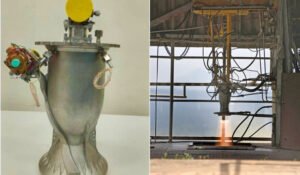
Why in news?
- The Indian Space Research Organisation (ISRO) recently made a significant leap in the world of space technology with the successful test of a 3D-printed rocket engine.
- This groundbreaking achievement marks a new era of possibilities in spacecraft design and manufacturing.
- But what exactly is 3D printing, and how is it revolutionizing the way we build rockets? Let’s delve deeper into this fascinating technology and explore the reasons behind ISRO’s decision to utilize it for their PS4 engine.
From Imagination to Reality: Unveiling the Magic of 3D Printing
- 3D printing, also known as additive manufacturing, is a revolutionary process that transforms computer-designed models into tangible three-dimensional objects.
- Unlike traditional subtractive manufacturing methods like carving or machining, which remove material from a solid block, 3D printing builds objects layer by layer.
- This additive approach offers immense flexibility and opens doors to design and manufacture complex structures that were previously unimaginable.
The Mechanics Behind the Magic
- The core principle of 3D printing involves using a computer-aided design (CAD) software to create a digital blueprint of the desired object.
- This digital model is then sliced into incredibly thin horizontal layers.
- The 3D printer, equipped with a material delivery system (often a nozzle), reads the sliced data and starts constructing the object layer by layer, depositing a specific material (plastic, metal, etc.) according to the design. As each layer hardens or fuses with the previous one, the object gradually takes shape, rising from the printer bed until the final form is complete.
Beyond Simple Shapes: The Power of 3D Printing
- The versatility of 3D printing allows for the creation of objects with intricate details, internal channels, and even moving parts.
- This technology empowers engineers to design lightweight yet robust structures, perfect for applications where weight reduction is crucial, like in the aerospace industry.
- Additionally, 3D printing enables on-demand manufacturing, eliminating the need for large inventories and allowing for rapid prototyping and customization.
ISRO’s Bold Move: Why 3D Printing for the PS4 Engine?
- ISRO’s decision to utilize 3D printing for their PS4 engine, used in the fourth stage of the Polar Satellite Launch Vehicle (PSLV), is a testament to the numerous advantages this technology offers. Here’s how 3D printing transformed the PS4 engine:
-
Simplified Design, Fewer Parts: Traditionally, the PS4 engine required 14 individual components. This new technique allowed ISRO to consolidate them into a single, unified structure. This not only simplifies the engine design but also eliminates the need for complex assembly procedures, reducing potential failure points.
-
Material Efficiency, Reduced Waste: The new manufacturing process allows for precise material deposition, minimizing waste generation. In the case of the PS4 engine, ISRO reports a staggering 97% reduction in raw material usage compared to conventional methods.
-
Faster Production Times: The traditional manufacturing process for the PS4 engine involved significant lead times. By leveraging this new technique, ISRO has achieved a remarkable 60% reduction in production time. This translates to faster turnaround times for building rockets and launching missions.
-
Beyond Rockets: How 3D Printing Will Shape Space Exploration
- ISRO’s success with the 3D-printed PS4 engine is a stepping stone towards a future where this technology plays a pivotal role in space exploration. Here are some exciting possibilities:
- On-Demand Manufacturing in Space: 3D printing has the potential to revolutionize space missions by enabling astronauts to manufacture spare parts, tools, or even spacecraft components directly on-demand, eliminating the need for pre-launch storage and transportation of critical parts.
- Customizable and Lightweight Rockets: 3D printing allows for the creation of lightweight yet strong structures, ideal for building efficient rockets capable of carrying heavier payloads into space. Additionally, the ability to customize designs opens doors for developing rockets optimized for specific missions.
- Lunar and Martian Infrastructure: As humanity ventures further into space, 3D printing could be instrumental in establishing lunar and Martian bases. By utilizing locally available resources like lunar regolith (soil), astronauts could print essential structures and habitats, paving the way for a permanent human presence beyond Earth.
Conclusion
- ISRO’s successful test of a 3D-printed rocket engine marks a significant milestone in the history of space exploration.
- This innovative approach not only optimizes engine design and manufacturing but also paves the way for a future where 3D printing plays a transformative role in space missions.
- As we continue to push the boundaries of space exploration, 3D printing holds immense potential to shape the future of rockets, spacecraft, and even lunar and Martian settlements
People also ask
Q1: What is 3D printing?
Ans: it is , also known as additive manufacturing, uses a computer-controlled process to create three-dimensional objects layer by layer. Unlike traditional methods that remove material from a solid block, 3D printing builds objects by depositing material based on a digital design.
Q2: Is 3D printing the future of space travel?
Ans: While this printing is a significant step forward, it’s likely to be one tool in a broader toolkit for space exploration. However, its ability to create complex structures on-demand and reduce reliance on pre-manufactured parts makes it a game-changer for future space missions.
Q3: Why did ISRO use 3D printing for the PS4 engine?
Ans: ISRO’s innovative approach to the PS4 engine yielded a three-fold win. By utilizing this new technique, they achieved a simplified design with fewer parts, minimizing potential issues during assembly. Additionally, precise material deposition significantly reduced waste. Most importantly, this method slashed production time by 60%, leading to faster rocket construction and launch capabilities.